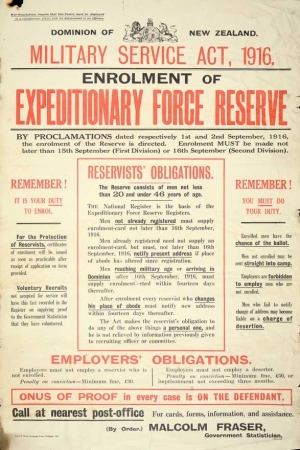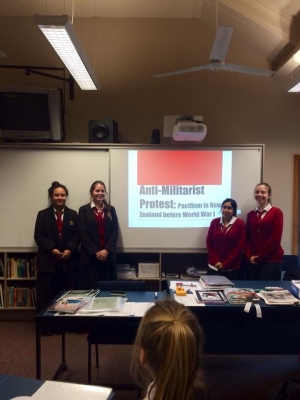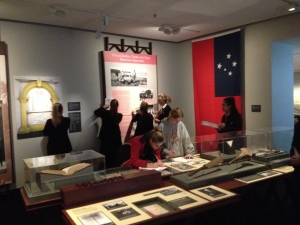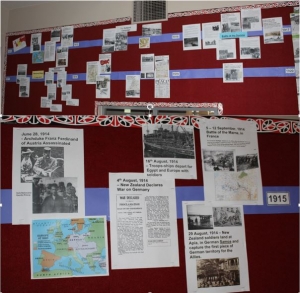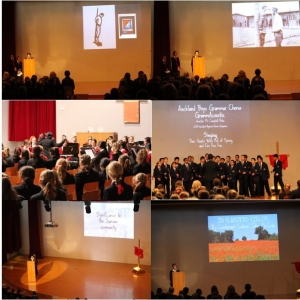Soldiersandorder NZ-FR
Conscription during War
We have researched who objected to conscription and refused to fight in the First World War. We came up with a number of key ideas when researching our topic about what type of people refused to fight during the First World War.
Conscription, which is the compulsory enlistment of people in the military forces, was not popular with all New Zealand people.
In 1915, 78 000 men stated that they were not willing to volunteer in New Zealand. Campaigns only managed to enlist 30% of those...The Fourteen Objectors Sent to France
The Fourteen sent to France - Research by Stephanie Upston and group
We have begun to research who the fourteen men were and how were these conscientious objectors were treated in New Zealand and France?
There were 14 men who were not prepared to fight these men include:
-Fred Adin
-Garth Ballantyne
-Alexander, John and Archibald Baxter
-Mark Briggs
-David Gray
-Thomas Harland
-Lawrence Kirwin
-William Little
-Daniel Magurie
-Henry Patton
-Lewis Penwright
-Albert Sanderson
...
Background to Anti-Militarism in New Zealand
This is research that we have started on Anti-Militarism in New Zealand at the time of the First World War. By Rose Stoddart, Claudia Wollaston, Indiya Dawson-Myers, Bella Hannah, Rewa Kendall.
An English language translation follows the French version of our update.
Définitions:
Pacifisme: La croyance que la guerre et la violence sont injustifiables.
Privation des droits civiques: l incapacité de voter.
Le fond de l'anti-militarisme
De petits groupes de Néo-Zélandais étaient contre les...
The Treatment of Conscientious Objectors in New Zealand - Wanganui Detention Barracks
Treatment of the Objectors – Wanganui Detention Centre
The policy implemented in which the objectors were treated by was extremely harsh with victims suffering brutal acts affecting them all physically, mentally and emotionally.
The grounds of the Wanganui Detention Barracks were often nicknamed the ‘slaughter yard’ with evidence of blood splatters displayed throughout the yard. Those who refused to co-operate were pushed, pulled, kicked and...Anti-Conscription During WW1
Anti-Conscription During World War One
What actions were undertaken by those involved in the movements against conscription of men as soldiers?
Religious objectors would not serve in the Army Service Unit or Medical Corps during the war while refusing to wear uniforms for non-combatant roles. 73 conscientious objectors had been exempted for religious reasons but in Trentham Military Camp, 15 religious objectors refused to do any work or wear uniforms. They were...Fourteen Men to France - research progress
Research Progress by Annie Kane, Louise Piggin, Danielle Mitchell, Laura McRae, Rewa Kendall and Mikayla Eruera
How were the conscientious objectors treated in NZ and France?
Conscientious objectors in NZ were not treated lightly. A conscientious objector is person who for reasons of conscience objects to serving in the armed forces.
Conscientious objectors in New Zealand were first sent to prison camps or were forced into hard labour as sentences for refusing to fight or responding to...
The Passive Resistance in New Zealand, prior to the outbreak of War.
Bonjour !
As part of our Shared Histories programme this year, our group will be researching the passive resistance in New Zealand prior to the outbreak of the War.
In this we will be researching significant groups in New Zealand which opposed the compulsory military training that was imposed upon the New Zealand working class by the government. The two main groups we researched are the Socialists and Christians.
The workers from the groups who opposed military training were often subjected...
Visit to Auckland War Memorial Museum
Over the last week the two Year 12 History classes at Baradene College have each visited the first exhibition to mark the 100th anniversary of the First World War at the Auckland War Memorial Museum in Auckland, New Zealand. This very good exhibition ‘Entangled Islands: Sāmoa, New Zealand and the First World War’ looks at the New Zealand invasion of German Sāmoa which took place on 29 August 1914. This event would entangle New Zealand and Sāmoa together and have a lasting impact on the cultures...
WWI Timeline Display
Students in Year 12 History created a timeline of important events in the First World War for New Zealand soldiers.
Baradene College Commemoration Assembly for the Outbreak of the First World War
Search
Who's Online?
The following members are online:
Latest Forum Posts
- No posts to display.
Powered by Technologywise / Design by yojodesign

